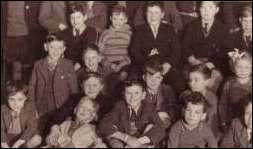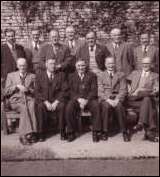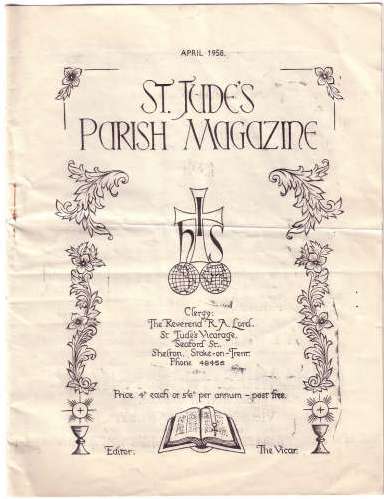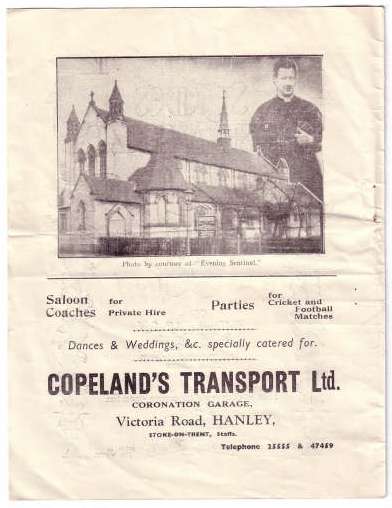|
Back to St Jude's
at the turn of the century. The old church became the Church Hall, and
in 1902 a new room was built at its west end by Mr Godwin (builder) to
replace two cottages in Beresford Street previously used as school
rooms. The new building was to be become
known as the
Schoolroom, but in later years became the Church Hall when the old
church became a theatre - the renowned Shelton Repertory Theatre.
Shelton Rep. now occupies a site in Leek Road near to the University.
|
In 1902 at a meeting
of the Annual Tea Committee, Mesdames Eason, Fuller, Pedley, Quick,
Whittingham and Mason were present - all well known names in the Parish,
and they or their next generation were well known to me as elderly
ladies during the 1940's and 50's. Doris Eason especially as she had a
grand St John Ambulance uniform. |
| In 1905 at the Vestry Meeting, a lavatory was proposed to be
installed at the rear of the Schoolroom by Mr Umpetby (builder)
at a cost of £25. |
|
Rev. Spink's curate,
Mr H. S. Stephenson resigned in 1905 and was replaced by Rev. J. Arthur
Price. He may have been the last Curate. |
| The new Parsonage in
Seaford Street was completed in 1907, a large multi-roomed, three storey
mansion in miniature. Previously the Rector had lived at No 5 Ashford
Street. |
|
In 1908 Rev. Spink
moved to Leek after 28 years in the Parish, and a moving tribute to him
was expressed by the Parochial Church Council in the form of an
Illuminated Address. |
|
In 1909
Rev. Henry R. Coldham was appointed to the living and left in 1917.
|
| In 1911 there was a sale of work at St
Anthony's Row
Mission Chapel in Newlands Street. |
|
In 1918 Rev. Samuel H.
Hare was appointed, but left in 1921 |
|
In 1924 Rev S. C. Stevens succeeded to the
living, and in the mid-1930's
was replaced by the Rev. James Taylor Birch. |
| In the early 1940's Rev. William Edge
became vicar (it appears that the old title of Rector had fallen into
disuse). He was an Oxford man, a keen sportsman and spent much time with
the young people of the parish, either at the Anglican Young People's
Association youth groups (Senior and Junior) in the Church Hall, or on
outings at week-ends. Mr Douglas Twigg was his irascible but highly
entertaining Organist and Choirmaster. Mrs Edge was a gentlewoman who
kept a maid. There was a thriving Mothers' Union, and a Church of
England Men's Society which the vicar and his wife oversaw. There was a
choir of 14 boys and 6 men, with a full rota of servers for all
services.

St. Jude's
children's party 1949
|
|
In 1954 Rev. Edge moved to Hixon and was
replaced by Rev. Broome from Holy Island, Northumberland, an austere,
monkish man in the best traditions of St. Cuthbert, with a light brown
voice (as described by a parishioner) and a pleasant wife with a talent
for Geordie folk-songs. |
1956 saw the arrival of Rev. Archibald
Royston Lord - a flamboyant, larger-than-life character who swept into
the Parish like a mischievous whirlwind. Rev. Edge had introduced
priestly vestments for Eucharist (older people preferred Holy
Communion) which raised eyebrows, but "The Lord",
as the new man was
irreverently called, introduced Mass, brighter and more ornate
vestments, incense, bells, confession and all manner of very high church
innovations. He was single, an ex-RAF chaplain, with Alfredo
an Italian cook, Anna an Austrian housekeeper, and Geoff a
companion also an ex-RAF type, who acted as his Personal Assistant, He
also had several lodgers of varying degrees of eccentricity, and Karl a
large black Labrador who slept on the Chancel steps during Divine
Service.

St. Jude's Wardens and
Sidesmen c.1956
The Lord kept open-house at the Vicarage,
which was invariably full of the young people of the Parish. He had an
explosive temper and was known to hit the Altar with his fist if the
ritual was not carried out to his standards. At one time he suspended
the AYPA for misconduct and apathy. His volatile and sometimes
inconsistent influence was not universally accepted, and may have
contributed to the waywardness of the younger generation. Rev. Lord left
the parish during the 1ate 1960's and went to
South Africa,
from where he occasionally appealed for financial help for his work.
He died there.

Cover of St. Jude's
Parish magazine of April 1958

Photo of the Church and
Rev R. A. Lord
The Rev. Bowdler was the last incumbent of
the Parish, and was the one to oversee its demise owing to drastically
reduced congregations. As previously mentioned, many of the younger
people had moved away, and the older people were dying off. It was
inevitable.
In May 1980 an Order in Council declared
that St Judes, Hanley was redundant, and in November 1981 a further
Order in Council authorised the demolition and sale of buildings and
land ("not of such historic or architectural interest that it ought to
be preserved").
And so it was. A painted wooden Triptych
from the Lady Chapel now stands in the Church of St Giles the Abbot,
Cheadle. What happened to the other artefacts is a mystery, as was the
fate of the marble wall tablets from the west end of the church - one
describing its origins, the other being the Roll of Honour, from which
on Armistice Day, or the nearest Sunday, the names of the fallen were
read out. In those days, the congregation included youngish men wearing
medals from the recently ended Second World War, many older men wearing
medals from the Great War, and men older still, wearing medals from
earlier wars. I particularly remember old Mr Hodges with his
reminiscences of Mesopotamia in 1917, and a fine bass voice.
  
next: St. Jude's 1900-1939
previous: the 'incomers'
|
![]()
![]()
![]()